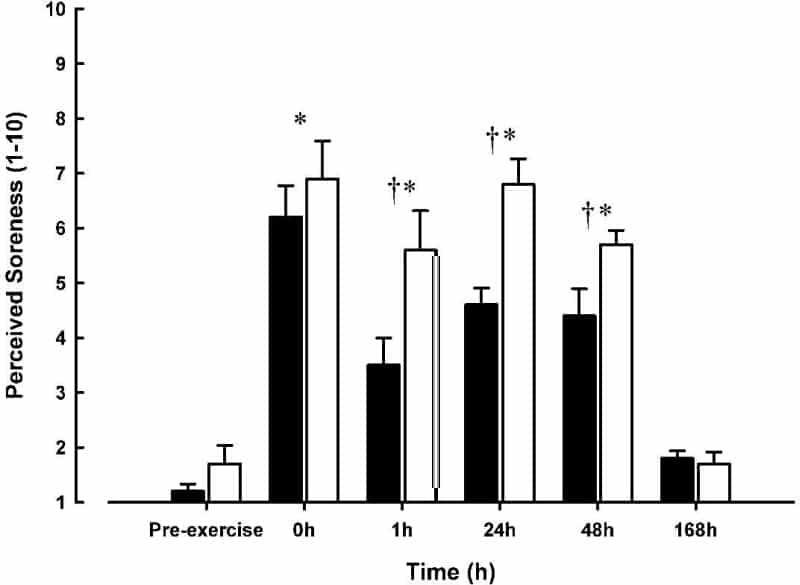The objective of this investigation was to elucidate the proposed ameliorative role of cryotherapy on indices of muscle damage following a bout of prolonged intermittent shuttle-running exercise. Following University Ethical Committee approval, twenty active males (age 22.7 ± 3.3 years, height 1.80 ± 0.05 m, body mass 83.7 ± 11.9 kg, VO2max 52.5 ± 4.9 ml.kg-1.min-1; mean ± S.D.) performed a 90 minute intermittent shuttle-run previously shown to result in marked muscle damage and soreness (Thompson et al. 1999). Immediately following exercise subjects were randomly assigned to either cryotherapy treatment (n=10) or a control group (n=10). Cryotherapy consisted of 10 minutes lower limb immersion in cold water (10 ± 2°C). Ratings of perceived soreness (visual analogue scale), isometric maximal voluntary contraction (MVC) of the leg extensors and flexors and efflux of intracellular proteins were monitored prior to exercise, treatment and then at regular intervals up to 7 days post-exercise. Data were analysed using a mixed-design factorial ANOVA. Exercise resulted in severe muscle soreness, temporary reduction in muscular function and elevated serum markers of muscle damage, all peaking within 48 hours post-exercise. Cryotherapy reduced muscle soreness at 1, 24 and 48 hours compared to the control group (p<0.05) (Fig. 1). Decrements in isometric maximal voluntary contraction of leg flexors were reduced following cryotherapy treatment at 24 (12 ± 4%) and 48 hours (3 ± 3%) compared to the control group (21 ± 5% and 14 ± 5%) (p<0.05). Exercise induced increases in serum creatine kinase activity peaking 24 hours (1302 ± 92 U.l-1, n=20) post-exercise (p<0.05), which was unaffected by cryotherapy. Serum myoglobin concentration was also elevated, peaking 1 hour post-exercise in the control group (45.9 ± 5.4 nmol.l-1) but this response was ameliorated with cryotherapy treatment (29.6 ± 4.8 nmol.l-1)(p<0.05). These findings suggest cold water immersion immediately following prolonged intermittent shuttle-running reduces some indices of exercise-induced muscle damage.
King's College London (2005) J Physiol 565P, PC22
Communications: Influence of cold water immersion on indices of muscle damage following prolonged intermittent shuttle-running exercise
Bailey, David M.; Erith, Sam J.; Griffin, P. Jonathan; Brewer, Daniel S.; Dowson, Anthony ; Williams, Clyde ;
1. School of Sport & Exercise Sciences, Loughborough University, Loughborough, United Kingdom.
View other abstracts by:
Figure 1: Perceived muscle soreness following exercise for cryotherapy (solid bars) and control (clear bars) groups. Values are mean ± S.E.M. * p<0.05 different from pre-exercise for both groups †p<0.05 different between groups.
Figure 2: Serum myoglobin concentration following exercise for cryotherapy (solid line) and control (broken line) groups. Values are mean ± S.E.M. * p<0.05 different from pre-exercise for both groups †p<0.05 different between groups.
Where applicable, experiments conform with Society ethical requirements.


